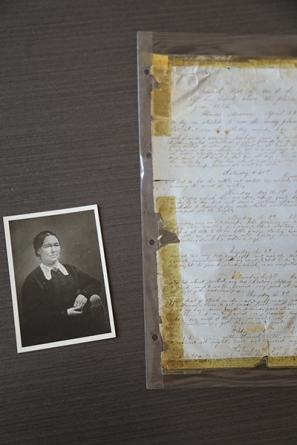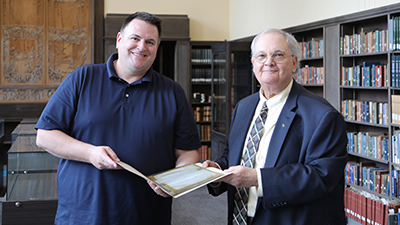“Tuesday the 3rd. Started at the usual hour, crossed two very bad creeks, the last was the Walkarnsha, camped about 5 o'clock, commenced raining about 8 o'clock pm and rained all night, a very bad night to guard stock, which we are compelled to do rain or shine.” —Elizabeth Goltra’s journal entry, May 3, 1853
Elizabeth Julia Ellison married Nelson Goltra in Jacksonville, Illinois, in 1851. Two years later the couple journeyed west on the Oregon Trail from Missouri to Oregon. Having graduated from college, Elizabeth assumed the task of recording the events of the trip, which she planned to send back to friends who were going to make the same trip later. Little could she know the extended journey her diary would ultimately make.
Sounding similar to a new college student, Goltra shared, “April 29th, 1853. To-day we started across the dreary plains. Sad are the thoughts that steal over the reflecting mind. I am leaving my home, my early friends and associates, perhaps never to see them again, exchanging the interested solicitude of fond friends for the cold and unsympathizing friendship of strangers.”

Turns out that May 3 (see her entry above) would be an auspicious date for both the journal and UO Libraries, with Goltra’s diary traveling the Oregon trail twice, once in 1853 and again 170 years later, in 2023, when it was returned to its forever home in Special Collections and University Archives (SCUA) at the University of Oregon (UO) in Eugene by Pete Brink, head of Archives and Special Collections at Creighton University.
But how did a pioneer woman’s diary documenting the arduous trek along the Oregon Trail in 1853 end up at Creighton University in Omaha, Nebraska?
In early 1988, “librarian Hillary Cummings at the University of Oregon in Eugene discovered that numerous rare books, documents, and manuscripts related to the early settling of Oregon and the west coast were missing, according to Kelly Jensen’s essay, “The Most Successful Book Thief in American History.” Cummings and the [then] chief librarian, George Shipman, alerted the FBI and let other libraries know about their missing special collections.
Once the UO theft had been detected, it took three SCUA librarians 548 hours spanning 1987–88 to inventory the collections to determine exactly which pieces were missing.
Meanwhile, FBI and other investigators were putting the puzzle pieces together and were able to identify the thief based on similar thefts at California and Washington universities.
The thief was Stephen Blumberg the most successful book thief of the 20th century, who became known as the “Book Bandit.” He was arrested in 1990 for stealing more than 21,000 rare books and manuscripts valued from $5.3 million to $20 million from more than 300 universities and museums in 45 states and 2 Canadian provinces. Law enforcement officials found wall-to-wall shelves on all floors of Blumberg’s home in Iowa overflowing with rare and highly valuable materials, including a copy of the Nuremberg Chronicles from 1493 and two dozen boxes of rare items about the settling of Oregon.
Relatively speaking, that arrest was the easy part. Finding the rightful owners of each book or manuscript and returning them was much, much harder. It took a cadre of volunteer librarians and archivists working out of the FBI office in Omaha to do that work. Despite their Herculean efforts, not all the materials were able to be returned to their original institutions. The FBI gave materials for which owners couldn’t be identified to Creighton University in recognition of the many volunteer hours its library staff provided. Goltra and her party encountered a similar act of generosity on the journey when some members of a Nez Perce tribe "came along with some potatoes and peas, which is a welcome vegetable to emigrants" (from her September 2, 1853, entry). Learn more about Creighton's role in the case of the greatest book thief in American history.
Brink was co-teaching a class on rare books, theft, and history and went into the Creighton Archives storage area to look for relevant materials. There, in a box, he found a red, expandable folder labeled “Goltra journal,” which piqued his interest. Immediately after looking at it he realized that it was something special. Creighton does not have a lot of Oregon Trail journals in their collections, so the fact that it wasn’t in their catalog set off alarm bells for Brink. He then went to Google to see who Elizabeth Goltra was and tracked down the UO’s Special Collections’ finding aid for the Goltra Journal, which noted that we only had photocopies of the journal, indicating that the original was missing.
Once he figured out what it was, Brink noted that it was “one of the most exciting things in the collection.” Goltra’s journal is one of the oldest diaries from the Oregon Trail journeys and offers valuable insight and perspective on the female experience of the Oregon Trail trek. Among them, for example, Goltra's opinion on appropriate language, "Sunday the 8th. Drove down on the bank of the river, so we would not be crowded out when our turn came. I have heard more swearing to-day, than I ever heard in one day before, or ever wish to again."
Brink then contacted David de Lorenzo, the Giustina director of Special Collections and University Archives, saying “I’m reaching out to you with a bit of an unusual question." de Lorenzo sent back a note with the 1990 memo from Fraser Cocks of UO, describing that he had found most of the missing items, but not the Goltra Journal. That’s when they knew that it had not been identified during the investigation and trial and had come to Creighton with the other items.

Upon the journal’s return, de Lorenzo stressed that making materials accessible is at the core of librarians’ and archivists’ work and the return of the journal is a reminder of that challenge and opportunity. "Librarians and archivists are the vanguards of the original artifacts,” said de Lorenzo.
Among the positive outcomes of Blumberg’s massive theft was that “security became a major topic of conversation within the rare materials community thereafter,” said Jensen in that 2022 essay. And “more standards were implemented where they hadn’t been before. As technology made communication among institutions even easier—as well as made security and digitization more accessible, acceptable, and expected—professional organizations have worked to ensure that the safety of priceless goods in such repositories stay available for research, study, and secure use for generations to come," added Jensen.
Researchers can view the Goltra collection in the Special Collections and University Archives Reading Room by appointment. Please contact SCUA in advance of a visit.
Given the journey Goltra’s journal has taken, it’s not surprising that it needs some repair. If you’re interested in contributing to its conservation, please contact David de Lorenzo at ddeloren@uoregon.edu.
—By Emily Moore, instruction and outreach archivist, Special Collections and University Archives, and Kate Conley, communications specialist, UO Libraries
